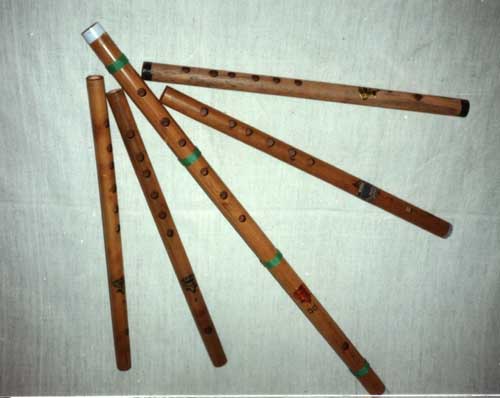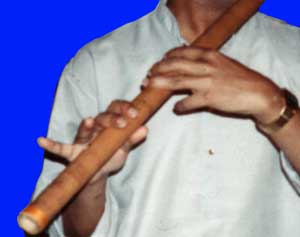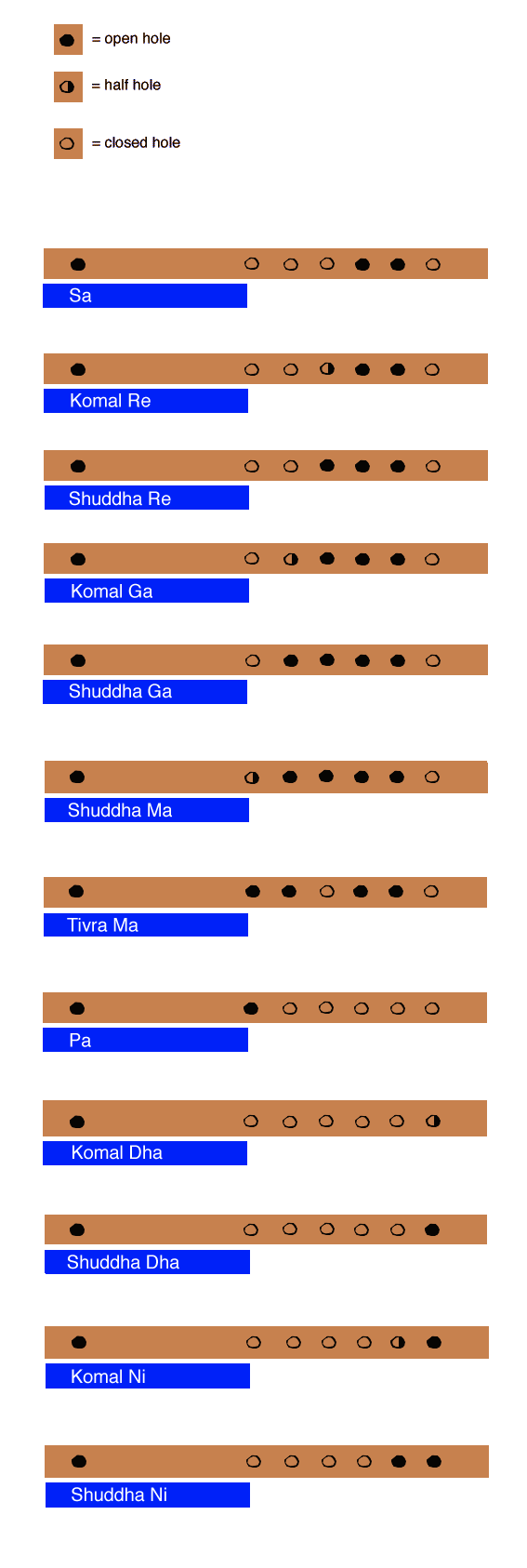
Bansuri and venu are common Indian flutes. They are typically made of bamboo or reed. There are two varieties; transverse and fipple. The transverse variety is nothing more than a length of bamboo with holes cut into it. This is the preferred flute for classical music because the embouchure gives added flexibility and control. The fipple variety is found in the folk and filmi styles, but seldom used for serious music. This is usually considered to be just a toy because the absence of any embouchure limits the flexibility of the instrument. The flute may be called many things in India: bansi, bansuri, murali, venu and many more.
There are two main types; bansuri and venu. The bansuri is used in the North Indian system. It typically has six holes, however there has been a tendency in recent years to use seven holes for added flexibility and correctness of pitch in the higher registers. It was previously associated only with folk music, but today it is found in Hindustani classical, filmi, and numerous other genre. Venu is the south Indian flute and is used in the Carnatic system. It typically has eight holes. The venu is very popular in all south Indian styles.
Cultural and Religious Significance
The bansuri is not just a musical instrument, because it has a great cultural and religious significance among Hindus. It is an instrument associated with Lord Krishna. Numerous common names reflect these epitaphs of Krishna. Common examples are: Venugopal, Bansilal, Murali, Muralidhar, etc. Furthermore, in traditional Indian metaphysics, it is noted how remarkable it is the way the life force (pran, or literally “breath”) is converted into a musical resonance (sur).
Parts of the Bansuri
We will now take a closer look at the north Indian Bansuri. It is always difficult to talk about the names for the various parts of the instrument because India is a land of many languages and dialects; therefore the following terms should be considered as representative but not universal.

Dandi – The dandi is the body of the bansuri. Bansuris may be fashioned from a variety of materials, but reeds, canes and bamboo are the most common. Ideally they should be constructed so that they taper towards the embouchure (mouth hole or mukharandra). They are therefore larger at the open end. This arrangement gives an extend range.
Mukha Randhra – This is the embouchure, or the blowing hole. professional quality bansuris in India are invariably of the transverse variety. However, there are also a number of fipple flutes which are also available. These are sometimes found among folk musicians and they are frequently given to children as toys. The transverse variety yields much better control by allowing blowing techniques to bend the notes to the desired pitches.
Swar Randhra – These are the finger holes. They are the holes that are used to play the melodies. For a 7-hole flute as shown in the side picture, the musical intervals are: half-step, whole-step, whole-step, half-step, whole-step, whole-step, whole-step. (Please note that these are approximations; the use of equal-temperament is not to be construed from this discussion.) The 7th hole (closest to the open end) is optional. When it is absent, the 6-hole flutes are tuned to: whole-step, whole-step, half-step, whole-step, whole-step, whole-step.
This 7th hole deserves special mention. Traditional north Indian folk flutes generally do not have it. The obvious advantage is that the presence of this hole extends the range of the instrument by one note. However, there is a more important and not quite so obvious advantage. Its presence gives the bansuri a more accurate pitch when overblown to produce the higher octaves.
Garbha Randhra – This is the opening of the bansuri. It should remain unoccluded at all times
Rassi – The body of the bansuri tends to crack. This is simply one of the undesirable qualities of bamboo and reed. This cracking may be reduced or eliminated by tightly binding the body with twine. This is known as rassi. One trick used by craftsmen to assure an even and reproducible tension is to tie a fixed weight to the end of the string and slowly turn the body of the bansuri to wrap the twine around it.
Technique
This is a very brief introduction to the technique of the North Indian bansuri.
The fingering position is shown in the accompanying photograph. Please note that the tips of the fingers are not used. Instead, it is the flat portion of the fingers, roughly an inch in from the tips that are used. This gives much more control when playing the half-holes (e.g., ornaments, flat notes).

Below are the fingerings for the notes of the Indian scale:

For more information on North Indian scales (gamut), click here.
For more information on north Indian scales (modes), click here.